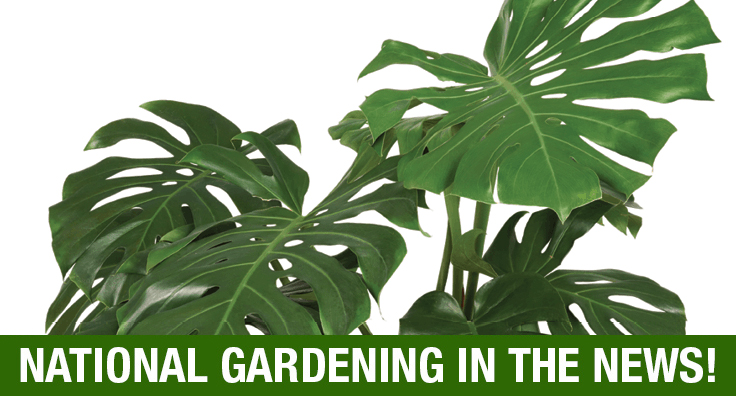
By Leslie F. Halleck
Tropical houseplants and “plant parenting” have been trending for a while now and by the looks of it, their stars will continue to rise in 2020. Tropical houseplant sales undoubtedly contributed to the rise in garden industry spending (up to a record $52 billion in 2018, according to the National Garden Bureau), but they also marked the increase of Millennials’ participation. Younger garden and houseplant consumers, who made up 25% of the customer base in the same study, now rival plant and garden spending by Gen Xrs and Boomers. As the market shifts, how do you shift?
Retail shift
There’s no apparent slowdown in non-green industry retailers getting into the houseplant-selling game. As I am writing this column, I just read that the furniture retailer West Elm will be selling houseplants online, courtesy of fulfillment by Bloomscape. Their selection will be limited to pretty much the same handful of tropicals that most other new online plant shops are offering, but it’s a move worth noticing.
Here’s the reality: Independent garden centers just do not want to retail online. Or, they just can’t seem to figure out how to even do so if they want to. Many are so far behind the game that I’m not sure they’ll catch up at this point. This reluctance to go digital has meant that IGCs have given up a good piece of market share to all of those new online houseplant vendors.
So how do you, as a grower, capitalize on the houseplant boom and move volume if your IGC customers just aren’t ordering enough from you? Like many other wholesale growers, you may be considering the shift to direct-to-consumer sales, if you haven’t already (see my last column on direct retailing: here). Or, you may consider making a fulfillment deal with a retailer — like what Bloomscape did with West Elm — so they bear the consumer-facing marketing burden. Either way, there is still plenty of wiggle room for boosting your tropical sales.
Focus on foliage
First, let’s pay attention to what’s already getting our customers’ attention. There is a serious focus on foliage color and form, specifically pink foliage color, variegation and unique leaf shapes. This includes the shadows and shapes a leaf will make in a space with different lighting. I’m not kidding. Leaf shadows are a big draw for customers who buy specimens of Monstera adansonii. Essentially, how a plant will add to and complement the aesthetics of one’s home is a top priority for many younger houseplant enthusiasts. Plants are pieces of living sculpture that adorn the plant parent’s home.
Plant priorities
While Gen X and Boomer customers tend to prioritize ease of care or low-maintenance houseplants, younger customers are prioritizing collecting unusual or rare species or varieties. They are willing to pay hefty prices to do so. That’s not to say, however, that they don’t eventually bail on specimens they find particularly difficult to maintain indoors. Succulents saw a big boost in popularity over the last few years, but it was accompanied with a high failure rate for many indoor growers without grow lights. Once a plant keeper realizes they need a grow light setup, then back to succulent and cacti collecting they may go.
The struggle is real
Speaking of grow lighting, and to follow up on my column from December (bit.ly/GM-grow-lights), indoor light, and where to place plants for best light access, is the biggest struggle for most houseplant keepers. That struggle puts them on the hunt for low-light plants that can handle their existing conditions. Even so, many new customers are also willing to shell out for artificial light setups to keep their houseplants happy.
Let’s take the light issue one step further: Considering how much time I spend these days explaining PPF, PPFD and DLI to amateur houseplant hobbyists, it might be time for the green industry to get much more clear about the lighting needs of each houseplant species when creating label copy. General light recommendations just aren’t cutting it.
More grow light manufacturers are finally starting to put meaningful PPF and PPFD output information on their packaging (versus lumens or foot-candles), so why aren’t we putting relevant quantifiable light volume requirements — such as DLI ranges — on plant tags? I realize that’s going to take a lot of new research to pinpoint this information for groups of tropicals and succulents, but I don’t see this information as any less important than USDA Hardiness Zones for outdoor garden plants.
So, who’s ready to start up an indoor houseplant light trials program?
Hot plants
The hot plants for 2020? I’m sure there will be many. While Pilea peperomioides held the top spot in 2018 and into 2019, philodendrons and Monstera have moved in to take the crown. Monstera adansonii seems to get the most attention and Monstera deliciosa is also holding strong. Less common philodendrons or pink foliage cultivars are selling strong. Rhaphidophora tetrasperma is in hot demand and low supply. I suspect money trees, Pachira aquatica, are set for a comeback. Unusual succulent specimens are still capturing fancy, and it looks to me like orchids are poised for a resurgence of interest.
And of course, I’m certain that teeny tiny cute tropicals are prime for a moment in the spotlight. So, if you have any new tiny cuties you need the world to see be sure to let me know, because I’m masterminding my new tiny plant collection as I type …
